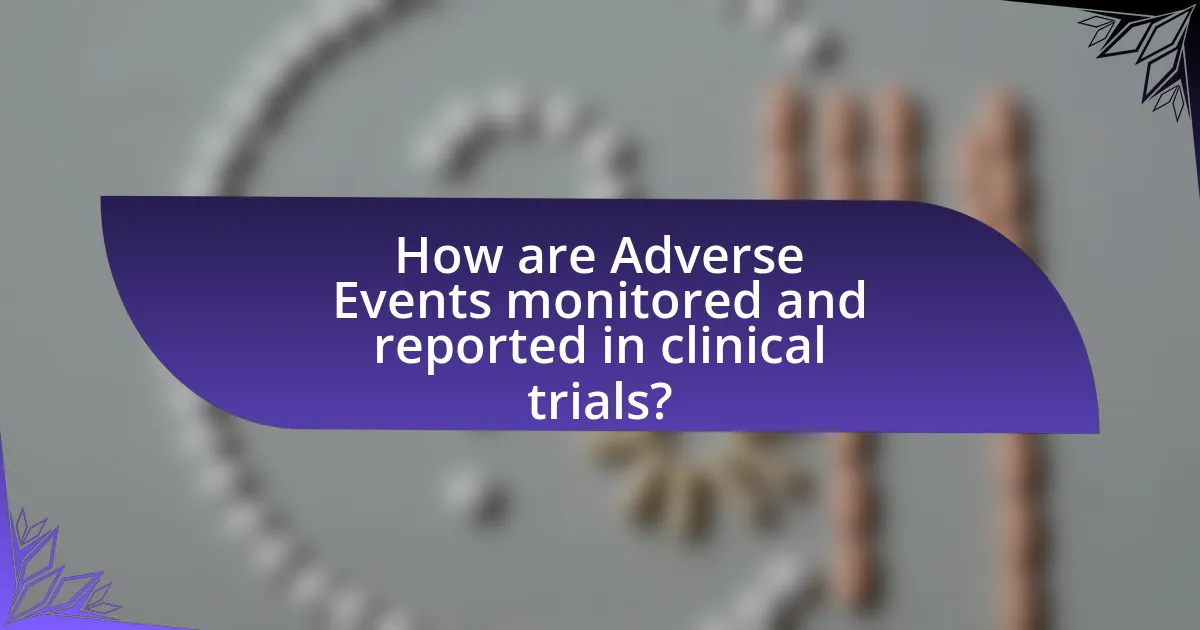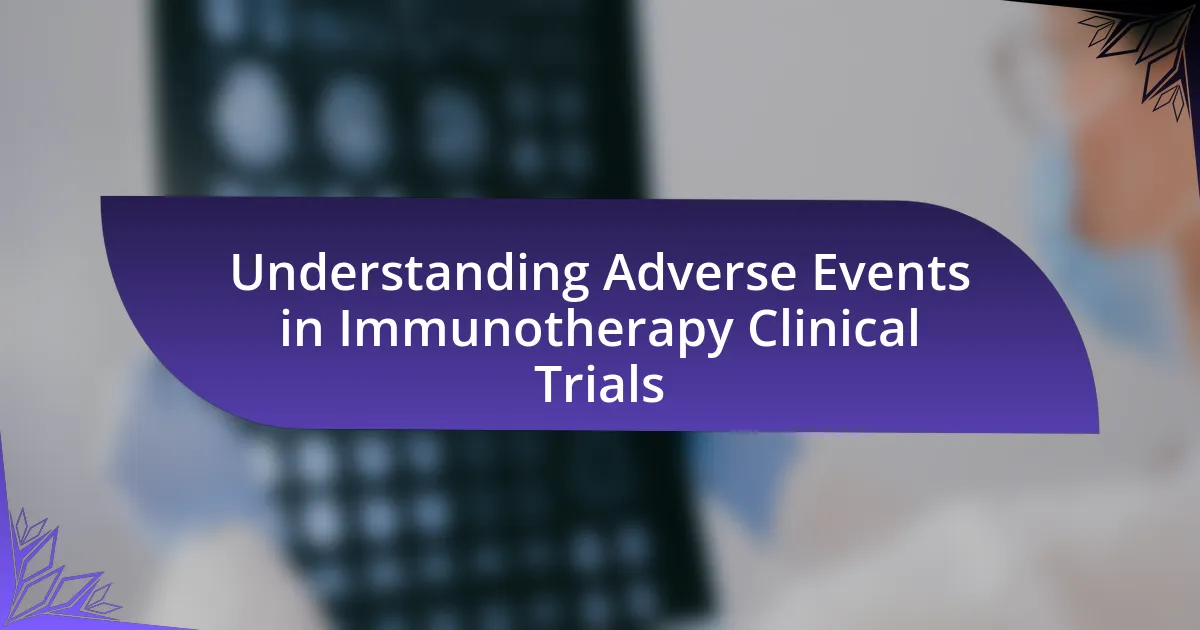Adverse events in immunotherapy clinical trials refer to unintended and harmful reactions experienced by participants due to treatment, ranging from mild symptoms to severe complications. Understanding these events is crucial for assessing patient safety and treatment efficacy, as they can significantly influence clinical trial outcomes and regulatory approval processes. The article outlines the definitions, classifications, and monitoring processes of adverse events, emphasizing their impact on patient safety and the design of future clinical trials. It also discusses common types of adverse events, their implications for research, and best practices for managing and communicating these events effectively.

What are Adverse Events in Immunotherapy Clinical Trials?
Adverse events in immunotherapy clinical trials are unintended and harmful reactions experienced by participants as a result of the treatment. These events can range from mild symptoms, such as fatigue or rash, to severe complications, including organ dysfunction or life-threatening conditions. The identification and reporting of adverse events are critical for assessing the safety and efficacy of immunotherapy agents, as they provide essential data for regulatory approval and inform clinical practice. According to the FDA, adverse events must be systematically monitored and documented to ensure participant safety and to evaluate the risk-benefit profile of the therapy being studied.
How are Adverse Events defined in the context of immunotherapy?
Adverse Events in the context of immunotherapy are defined as any undesirable experiences or side effects that occur during or after the administration of immunotherapeutic agents. These events can range from mild reactions, such as fatigue or rash, to severe complications, including autoimmune disorders or organ dysfunction. The National Cancer Institute (NCI) categorizes these events based on their severity and relationship to the treatment, emphasizing the importance of monitoring and reporting them in clinical trials to ensure patient safety and treatment efficacy.
What criteria are used to classify Adverse Events?
Adverse Events are classified based on criteria such as severity, relationship to the treatment, and outcome. Severity is often categorized into grades, typically ranging from mild (Grade 1) to life-threatening (Grade 4), as defined by the Common Terminology Criteria for Adverse Events (CTCAE). The relationship to treatment assesses whether the event is likely related to the administered therapy, which can be classified as unrelated, unlikely, possibly, probably, or definitely related. The outcome of the event, including whether it resolved, was ongoing, or resulted in death, also plays a crucial role in classification. These criteria ensure a standardized approach to monitoring and reporting adverse events in clinical trials, facilitating better safety assessments and regulatory compliance.
How do regulatory bodies define Adverse Events?
Regulatory bodies define Adverse Events (AEs) as any undesirable experiences associated with the use of a medical product in a patient. This definition encompasses a wide range of occurrences, including any unfavorable or unintended signs, symptoms, or diseases that arise during treatment, regardless of whether they are considered related to the medical product. For instance, the U.S. Food and Drug Administration (FDA) and the European Medicines Agency (EMA) both emphasize that AEs can occur at any time during the clinical trial process and must be reported to ensure patient safety and the integrity of the trial data.
Why is understanding Adverse Events important in immunotherapy?
Understanding adverse events is crucial in immunotherapy because it directly impacts patient safety and treatment efficacy. Adverse events can indicate how the immune system is responding to therapy, helping clinicians to manage side effects effectively and adjust treatment plans. For instance, studies have shown that approximately 60% of patients undergoing immune checkpoint inhibitor therapy experience some form of adverse event, highlighting the need for careful monitoring and understanding of these reactions to optimize patient outcomes.
What impact do Adverse Events have on patient safety?
Adverse events significantly compromise patient safety by increasing the risk of harm during medical treatments. These events can lead to severe complications, prolonged hospital stays, and even mortality, as evidenced by studies indicating that approximately 10% of hospitalized patients experience an adverse event, with a notable percentage resulting in serious injury or death. Furthermore, in the context of immunotherapy clinical trials, adverse events can lead to treatment discontinuation and affect the overall efficacy of the therapeutic approach, thereby undermining patient trust and safety in clinical settings.
How do Adverse Events influence clinical trial outcomes?
Adverse events significantly influence clinical trial outcomes by affecting participant safety, treatment efficacy, and overall trial integrity. When adverse events occur, they can lead to modifications in trial protocols, such as dose adjustments or even trial termination, which directly impacts the assessment of the treatment’s effectiveness. For instance, a study published in the Journal of Clinical Oncology found that 30% of patients experienced serious adverse events, which resulted in altered treatment regimens and affected the overall results of the trial. Additionally, the reporting of adverse events is crucial for regulatory approval, as it provides insights into the risk-benefit profile of the intervention being tested. Therefore, the presence and management of adverse events are critical factors that shape the outcomes and conclusions drawn from clinical trials.
What types of Adverse Events are commonly observed in immunotherapy trials?
Commonly observed adverse events in immunotherapy trials include immune-related adverse events (irAEs), which can affect various organs such as the skin, gastrointestinal tract, liver, and endocrine glands. These events arise due to the activation of the immune system against normal tissues, leading to conditions like dermatitis, colitis, hepatitis, and endocrinopathies. Studies indicate that approximately 60% of patients receiving immune checkpoint inhibitors experience some form of irAE, with severe events occurring in about 10-20% of cases. This data underscores the significance of monitoring for these adverse events during immunotherapy.
What are the most frequent immune-related Adverse Events?
The most frequent immune-related adverse events (irAEs) include skin reactions, colitis, hepatitis, endocrinopathies, and pneumonitis. Skin reactions, such as rash and pruritus, occur in approximately 30-40% of patients receiving immune checkpoint inhibitors. Colitis, characterized by diarrhea and abdominal pain, affects about 10-20% of patients. Hepatitis, presenting as elevated liver enzymes, occurs in 5-10% of cases. Endocrinopathies, including thyroiditis and adrenal insufficiency, can affect 5-10% of patients as well. Pneumonitis, which manifests as cough and dyspnea, occurs in about 3-5% of patients. These statistics are derived from clinical trial data and real-world studies assessing the safety profiles of immunotherapy agents.
How do the types of Adverse Events vary by immunotherapy class?
Adverse events vary significantly by immunotherapy class, with each class exhibiting distinct profiles of side effects. For instance, immune checkpoint inhibitors, such as PD-1 and CTLA-4 inhibitors, commonly lead to immune-related adverse events like colitis, pneumonitis, and endocrinopathies due to their mechanism of enhancing immune responses. In contrast, CAR T-cell therapies are associated with unique toxicities such as cytokine release syndrome and neurotoxicity, which arise from the rapid activation of T-cells. Additionally, oncolytic virus therapies may cause flu-like symptoms and localized inflammation at the tumor site. These variations in adverse events are documented in clinical trials, highlighting the importance of understanding the specific risks associated with each immunotherapy class for effective patient management.

How are Adverse Events monitored and reported in clinical trials?
Adverse Events in clinical trials are monitored and reported through systematic processes involving data collection, assessment, and regulatory compliance. Clinical trial investigators are responsible for identifying and documenting any adverse events that occur during the study, using standardized definitions and grading scales, such as the Common Terminology Criteria for Adverse Events (CTCAE). These events are then reported to regulatory authorities, such as the FDA or EMA, within specified timelines, ensuring that any serious adverse events are communicated promptly. This monitoring process is crucial for evaluating the safety profile of the investigational treatment and is supported by guidelines from organizations like the International Conference on Harmonisation (ICH), which emphasizes the importance of rigorous safety monitoring in clinical research.
What processes are in place for monitoring Adverse Events?
Monitoring adverse events in immunotherapy clinical trials involves systematic processes including the collection, assessment, and reporting of adverse events. These processes typically utilize standardized protocols such as the Common Terminology Criteria for Adverse Events (CTCAE) to classify and grade the severity of events. Additionally, data safety monitoring boards (DSMBs) are established to review safety data periodically and ensure participant safety throughout the trial. Regulatory bodies like the FDA require sponsors to report serious adverse events within specific timelines, ensuring compliance and oversight. These structured approaches are essential for maintaining participant safety and integrity of the trial data.
How do clinical trial protocols ensure comprehensive reporting?
Clinical trial protocols ensure comprehensive reporting by establishing standardized guidelines for data collection, analysis, and reporting of adverse events. These protocols outline specific criteria for identifying, documenting, and classifying adverse events, which enhances consistency and accuracy across trials. For instance, the International Conference on Harmonisation (ICH) Good Clinical Practice guidelines mandate that protocols include detailed definitions of adverse events and the methods for their assessment, ensuring that all participating sites adhere to the same standards. This uniformity facilitates the aggregation of data, allowing for a more thorough evaluation of safety and efficacy in immunotherapy clinical trials.
What role do Data Safety Monitoring Boards play in this process?
Data Safety Monitoring Boards (DSMBs) play a critical role in overseeing the safety and efficacy of clinical trials, including those focused on immunotherapy. DSMBs are independent groups of experts who monitor trial data to ensure participant safety, assess treatment efficacy, and determine whether a trial should continue, be modified, or be halted based on emerging data. Their oversight is essential in identifying adverse events and ensuring that the benefits of the treatment outweigh the risks, which is particularly important in immunotherapy trials where adverse reactions can be significant. The presence of DSMBs helps maintain the integrity of the trial and protects the welfare of participants, as evidenced by regulatory guidelines that mandate their establishment in many clinical trials.
How is data on Adverse Events collected and analyzed?
Data on Adverse Events is collected through systematic reporting mechanisms, including clinical trial protocols, patient questionnaires, and electronic health records. These methods ensure comprehensive documentation of any adverse events experienced by participants during immunotherapy clinical trials. The analysis of this data typically involves statistical methods to identify patterns, frequency, and severity of adverse events, often utilizing software tools designed for pharmacovigilance. Regulatory agencies, such as the FDA, require this data to be reported in a standardized format, which facilitates comparison across studies and helps in assessing the safety profile of the immunotherapy agents.
What tools and methodologies are used for data collection?
Data collection in immunotherapy clinical trials employs various tools and methodologies, including surveys, electronic health records (EHRs), and clinical trial management systems (CTMS). Surveys facilitate the gathering of patient-reported outcomes and adverse event experiences, while EHRs provide comprehensive patient data, including demographics and treatment history. CTMS streamline data management by tracking trial progress and participant information. These methodologies ensure accurate and efficient data collection, which is crucial for assessing the safety and efficacy of immunotherapy treatments.
How is the severity of Adverse Events assessed in trials?
The severity of Adverse Events (AEs) in trials is assessed using standardized grading systems, such as the Common Terminology Criteria for Adverse Events (CTCAE). These systems categorize AEs based on their intensity, ranging from mild (Grade 1) to life-threatening (Grade 4) or fatal (Grade 5). The CTCAE provides specific criteria for each grade, allowing researchers to consistently evaluate and report the severity of AEs across different studies. This standardized approach ensures that the assessment of AEs is objective and comparable, facilitating the analysis of safety profiles in immunotherapy clinical trials.

What are the implications of Adverse Events for future immunotherapy research?
Adverse events significantly impact future immunotherapy research by necessitating enhanced safety monitoring and risk assessment protocols. These events can lead to the identification of specific patient populations that may be more susceptible to severe reactions, thereby guiding the development of more tailored treatment approaches. For instance, studies have shown that certain biomarkers can predict adverse reactions, which can inform patient selection and dosing strategies. Furthermore, the occurrence of adverse events can drive the need for innovative therapeutic strategies, such as combination therapies that may mitigate these risks while maintaining efficacy. This evolving understanding of adverse events ultimately shapes regulatory frameworks and influences clinical trial designs, ensuring that patient safety remains a priority in the advancement of immunotherapy.
How do Adverse Events affect the design of future clinical trials?
Adverse events significantly influence the design of future clinical trials by necessitating adjustments in protocols, safety monitoring, and patient selection criteria. When adverse events are identified in previous trials, researchers analyze their frequency, severity, and potential causative factors, leading to modifications in trial designs to enhance patient safety and efficacy. For instance, the incorporation of adaptive trial designs allows for real-time adjustments based on adverse event data, thereby improving the overall risk-benefit assessment. Additionally, regulatory agencies often require more stringent safety evaluations and reporting mechanisms in subsequent trials, which can include increased sample sizes or longer follow-up periods to monitor long-term effects. This iterative process ensures that future clinical trials are better equipped to manage and mitigate risks associated with adverse events, ultimately leading to more reliable and safer therapeutic interventions.
What strategies can be implemented to minimize Adverse Events?
Implementing comprehensive risk assessment and management strategies can significantly minimize adverse events in immunotherapy clinical trials. These strategies include thorough patient screening to identify individuals at higher risk for adverse reactions, continuous monitoring of patients during and after treatment, and establishing clear protocols for managing adverse events when they occur. Additionally, utilizing biomarkers to predict responses and adverse effects can enhance patient safety. Research indicates that proactive management and early intervention can reduce the incidence and severity of adverse events, thereby improving overall trial outcomes.
How can understanding Adverse Events lead to improved patient outcomes?
Understanding adverse events can lead to improved patient outcomes by enabling healthcare providers to identify, manage, and mitigate risks associated with immunotherapy treatments. By analyzing data from clinical trials, researchers can pinpoint specific adverse events that may arise, allowing for the development of tailored monitoring protocols and intervention strategies. For instance, a study published in the Journal of Clinical Oncology found that early recognition and management of immune-related adverse events significantly improved treatment adherence and overall survival rates in patients undergoing immunotherapy. This evidence underscores the importance of understanding adverse events to enhance patient safety and therapeutic efficacy.
What best practices should researchers follow regarding Adverse Events?
Researchers should systematically document and report all adverse events (AEs) encountered during immunotherapy clinical trials. This practice ensures transparency and safety, as mandated by regulatory bodies like the FDA and EMA, which require comprehensive AE reporting to evaluate the risk-benefit profile of treatments. Additionally, researchers should implement standardized definitions and grading scales for AEs, such as the Common Terminology Criteria for Adverse Events (CTCAE), to maintain consistency in reporting. Regular training on AE recognition and management for clinical staff is also essential to enhance the accuracy of AE documentation. Furthermore, establishing a robust data monitoring committee can facilitate timely review and intervention for serious AEs, thereby safeguarding participant welfare and ensuring compliance with ethical standards.
How can effective communication about Adverse Events be ensured?
Effective communication about Adverse Events can be ensured through standardized reporting protocols and clear guidelines for stakeholders. Implementing a structured framework, such as the Common Terminology Criteria for Adverse Events (CTCAE), allows for consistent documentation and understanding of adverse events across clinical trials. Research indicates that utilizing electronic health records and real-time reporting systems enhances the accuracy and timeliness of adverse event communication, thereby improving patient safety and regulatory compliance.
What training is necessary for clinical trial staff to manage Adverse Events?
Clinical trial staff must undergo specialized training in pharmacovigilance, regulatory requirements, and clinical assessment to effectively manage Adverse Events (AEs). This training includes understanding the definitions and classifications of AEs, recognizing the signs and symptoms associated with immunotherapy-related AEs, and knowing the reporting procedures mandated by regulatory bodies such as the FDA and EMA. Additionally, staff should be trained in risk management strategies and the ethical considerations involved in patient safety. Evidence from the International Conference on Harmonisation (ICH) guidelines emphasizes the importance of such training to ensure compliance and enhance patient safety during clinical trials.



